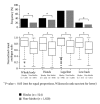Statistical analysis of hie (cold sensation) and hiesho (cold disorder) in kampo clinic
- PMID: 24489584
- PMCID: PMC3893778
- DOI: 10.1155/2013/398458
Statistical analysis of hie (cold sensation) and hiesho (cold disorder) in kampo clinic
Abstract
A cold sensation (hie) is common in Japanese women and is an important treatment target in Kampo medicine. Physicians diagnose patients as having hiesho (cold disorder) when hie disturbs their daily activity. However, differences between hie and hiesho in men and women are not well described. Hie can be of three types depending on body part where patients feel hie. We aimed to clarify the characteristics of patients with hie and hiesho by analyzing data from new patients seen at the Kampo Clinic at Keio University Hospital between 2008 and 2013. We collected information about patients' subjective symptoms and their severity using visual analogue scales. Of 4,016 new patients, 2,344 complained about hie and 524 of those were diagnosed with hiesho. Hie was most common in legs/feet and combined with hands or lower back, rather than the whole body. Almost 30% of patients with hie felt upper body heat symptoms like hot flushes. Cold sensation was stronger in hiesho than non-hiesho patients. Patients with hie had more complaints. Men with hiesho had the same distribution of hie and had symptoms similar to women. The results of our study may increase awareness of hiesho and help doctors treat hie and other symptoms.
Figures




References
-
- Ishino S. Kampo medicine for Outpatients clinic. Sanfujinka Chiryo Obstetrical and Gynecological Therapy. 2001;82(3):344–348.
-
- Terasawa K. On the recognition and treatment of “Hie-sho” (chillphobia) in the traditional Kampoh medicine. Shoyakugaku Zasshi. 1987;41(2):85–96.
-
- Imai M, Akasofu K, Fukunishi H. A study on the factors and awareness of the cold sensation of the adult females. Ishikawa Journal of Nursing. 2007;4:55–64.
-
- Kondo M, Okamura Y. Cold constitution: analysis of the questionnaire. Acta Obstetrica et Gynaecologica Japonica. 1987;39(11):2000–2004. - PubMed
LinkOut - more resources
Full Text Sources
Other Literature Sources

